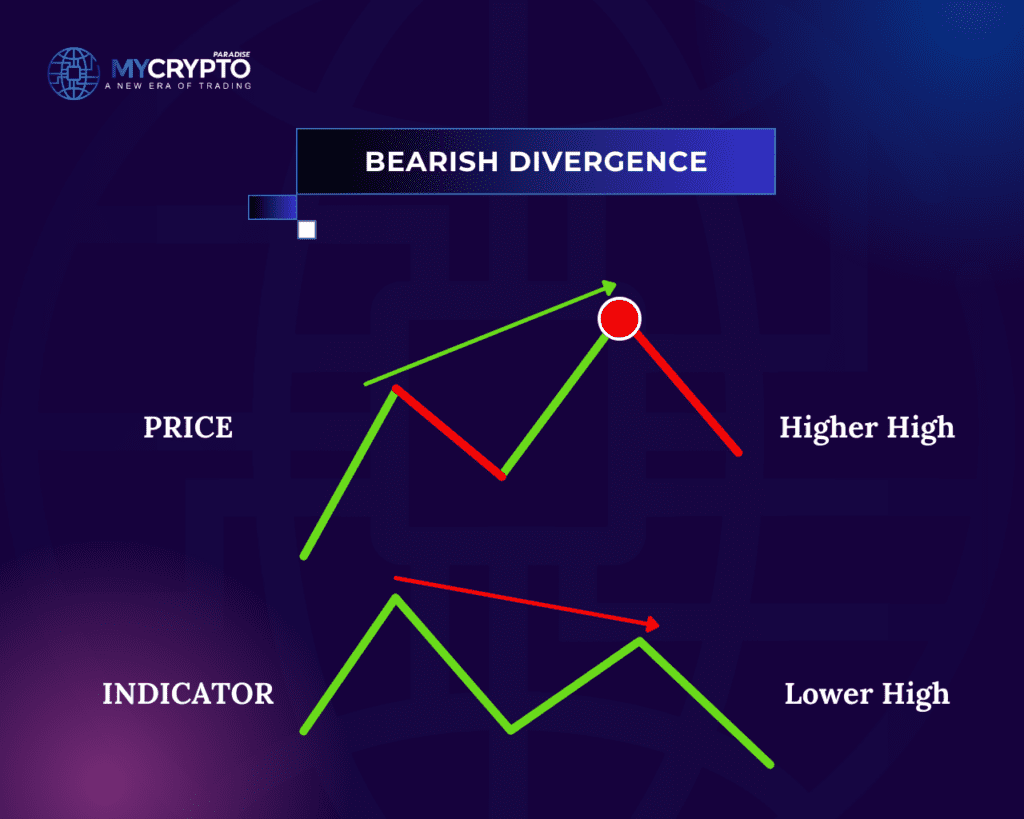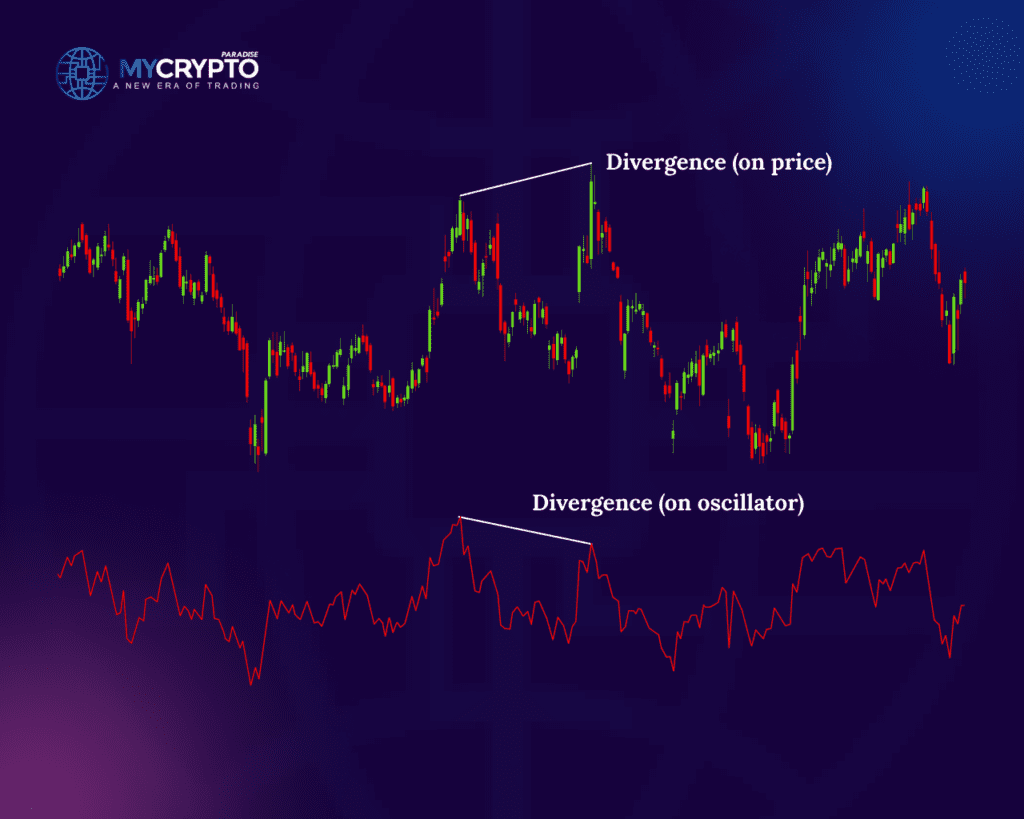In the world of cryptocurrency trading, technical analysis is a crucial tool that traders use to make informed decisions. One popular aspect of technical analysis is the identification of market trends using indicators. Among these indicators, bearish divergence stands out as a powerful tool for predicting potential reversals in the market. In this article, we will delve into the concept of bearish divergence and explore its application in crypto trading.
What is Bearish Divergence?

Bearish divergence refers to a situation where the price of an asset, in this case, a cryptocurrency, forms higher highs while the corresponding indicator, typically an oscillating indicator, forms lower highs. It signifies a weakening of buying pressure and a potential shift from a bullish to a bearish trend. Bearish divergence is considered a leading indicator, providing traders with an early warning sign of a possible trend reversal.
Identifying Bearish Divergence

To identify bearish divergence, traders commonly use oscillating indicators such as the Relative Strength Index (RSI), Moving Average Convergence Divergence (MACD), or Stochastic Oscillator. These indicators are widely available on most cryptocurrency trading platforms. The process of identifying bearish divergence typically involves the following steps:
1. Analyzing Price Action: Begin by examining the price chart of the cryptocurrency you are trading. Look for a series of higher highs, indicating an upward trend.
2. Analyzing the Indicator: Simultaneously, analyze the corresponding oscillating indicator, such as the RSI. Look for a series of lower highs on the indicator, which would indicate a weakening momentum.
3. Drawing Trendlines: Connect the highs on the price chart and the corresponding highs on the indicator using trendlines. This will help visualize the divergence more clearly.
4. Confirming the Divergence: To confirm the bearish divergence, wait for the price to reverse and start moving downwards. The confirmation occurs when the price breaks below the trendline connecting the higher highs.
Interpreting Bearish Divergence
Bearish divergence suggests that the prevailing bullish trend is losing its momentum and a reversal may be on the horizon. It indicates that despite higher highs in price, there is less buying pressure and potential selling pressure building up. This divergence between price action and the oscillating indicator often warns traders of an impending trend reversal or correction.
Bearish divergence can provide valuable insights into the market sentiment and act as an early signal for crypto traders to consider adjusting their positions. However, it is important to note that bearish divergence does not guarantee an immediate trend reversal. It serves as a warning sign, and additional analysis and confirmation are necessary before making trading decisions.
Applying Bearish Divergence in Crypto Trading

Bearish divergence can be a powerful tool when incorporated into a comprehensive trading strategy. Here are a few ways traders can utilize bearish divergence in their crypto trading:
1. Timing Entries: When bearish divergence is identified, it can be an opportune moment to consider shorting the cryptocurrency or closing long positions. Traders can use this indication to time their entries into the market more effectively.
2. Setting Stop Losses: Bearish divergence can help traders determine suitable levels for placing stop-loss orders. By identifying potential trend reversals, traders can set their stop-loss orders above the trendline, limiting potential losses if the market turns against their position.
3. Confirming Reversals: Bearish divergence can act as a confirmation tool when combined with other technical analysis indicators. Traders often look for additional signals, such as bearish candlestick patterns or trendline breaks, to further validate the potential trend reversal.
4. Adjusting Risk Management: Recognizing bearish divergence prompts traders to reassess their risk management strategies. Traders may choose to reduce their position sizes, tighten their stop-loss levels, or even exit the market altogether to protect their capital.
In ParadiseFamilyVIP, we send crypto signals which you get from our team of professional traders. Use the code PRO20% to get 20% discount and contact us here.
How to Set Up Entry, Take Profit, and Stop Loss for a Bearish Divergence Trading Signal
Setting up entry, take profit, and stop loss levels when trading bearish divergence requires a systematic approach to maximize potential profits and manage risk effectively. Here’s a guide on how to set up these parameters:
Entry Point
When trading bearish divergence, the entry point is crucial. It’s recommended to wait for confirmation of the bearish reversal before entering a trade. This confirmation can come in the form of a breakdown below the trendline connecting the higher highs or a bearish candlestick pattern.
a. Trendline Break: Wait for the price to break below the trendline that connects the higher highs identified during the bearish divergence. This break serves as a confirmation that the trend reversal is underway.
b. Bearish Candlestick Pattern: Look for bearish candlestick patterns such as a bearish engulfing pattern, shooting star, or evening star formation. These patterns can provide additional confirmation of the bearish reversal.
Once the confirmation signal is present, traders can initiate a short position or close their existing long positions.
Take Profit
Determining the take profit level depends on various factors, including the trader’s risk appetite, market conditions, and the timeframe being traded. Here are a few approaches to consider:
a. Support Levels: Identify key support levels on the price chart, such as previous swing lows or areas of historical price support. These levels can act as potential profit targets. Traders may choose to exit the trade partially or entirely when the price reaches these support levels.
b. Fibonacci Extensions: Fibonacci extensions can be used to identify potential profit targets. Traders can apply the Fibonacci tool from the swing high to the swing low of the bearish move and look for extension levels, such as 127.2% or 161.8%, as potential take profit levels.
c. Oscillating Indicators: Monitor oscillating indicators, such as the RSI or MACD, for signs of oversold conditions. When the indicator reaches oversold levels and shows signs of reversal, it could indicate a potential exit point.
Stop Loss
Implementing a stop loss is essential in risk management to protect against unexpected market movements. Here are a few methods for determining an appropriate stop loss level:
a. Above the Divergence Trendline: Set the stop loss slightly above the trendline connecting the higher highs identified during the bearish divergence. This level acts as a stop loss if the price retraces and breaks back above the trendline, indicating a potential invalidation of the bearish reversal.
b. Recent Swing High: Place the stop loss order just above the most recent swing high. This approach helps to limit potential losses if the price unexpectedly reverses and resumes the previous bullish trend.
c. Volatility-Based Stop Loss: Calculate the average true range (ATR) of the asset to gauge its recent volatility. Multiply the ATR by a factor, such as 2 or 3, and set the stop loss at that distance from the entry point. This method adjusts the stop loss based on the market’s volatility, allowing for greater flexibility.
What Indicates that a Bearish Divergence Signal will be Profitable?
Profitability depends on various factors and requires additional analysis and confirmation. Here are a few indicators that can increase the likelihood of a profitable bearish divergence signal:
1. Strong Divergence: Look for clear and significant divergence between the price action and the indicator. The greater the divergence, the stronger the potential signal. A substantial difference between higher highs in price and lower highs on the indicator suggests a more significant shift in momentum.
2. Confluence with Other Signals: Bearish divergence should be considered in conjunction with other technical analysis tools and indicators. Look for additional signals that support the bearish bias, such as bearish candlestick patterns, trendline breaks, or other oscillating indicators aligning with the bearish divergence signal. The convergence of multiple indicators increases the probability of a profitable trade.
3. Volume Confirmation: Analyze trading volume alongside the bearish divergence signal. Increasing selling volume or a notable decrease in buying volume can strengthen the bearish case. Higher volume during the bearish reversal can indicate increased market participation and validate the potential profitability of the signal.
Conclusion
Bearish divergence is a valuable tool in the arsenal of technical analysis when trading cryptocurrencies. By identifying a weakening bullish trend, it provides traders with an early indication of a potential trend reversal. However, it is important to remember that bearish divergence should not be used in isolation. It is always advisable to combine it with other technical analysis tools and indicators to increase the probability of successful trades.
The knowledge you’ve gained through this article is a great start, but it’s only the beginning. While it can provide you with an edge, consistent long-term profitability over the next 3+ years requires pairing that knowledge with effective trading strategies and precise tactics.
At ParadiseFamilyVIP, we combine our technical analysis expertise, on-chain insights, accurate sentiment tracking, and deep whale psychology understanding with powerful trading strategies to ensure our long-term success. This is how we deliver top-notch crypto signals and portfolio management for consistent profitability.
We offer full transparency by sharing every trade we enter, our planned exit points, and the percentage of our portfolio we allocate. This allows you to follow our approach and achieve the same results.
If you’re serious about becoming a PRO trader and want to learn from how we trade, joining our inner circle is the best way to gain this knowledge. Membership is limited, so if the group you want is full, don’t forget to join the waiting list.
Our service is a premium offering, so it’s designed for traders with enough capital. If you’re still building your trading funds, we recommend starting with our FREE Telegram channels to build your skills.
To check availability and secure your spot in ParadiseFamilyVIP, click here: https://mycryptoparadise.com/paradisefamilyvip/
We trade exclusively on four carefully vetted exchanges, where we’ve secured up to 35% off fees and deposit bonuses for our members. These exchanges are fully trusted by the ParadiseTeam, offering top-tier security and legitimate management. We trust them with our own capital, and in ParadiseFamilyVIP, we generate our signals using the best liquidity and coins available on these platforms. We share the exclusive links for free 💙🌴
MEXC: https://www.mexc.com/landings/MyCryptoParadise?handleDefaultLocale=keep&inviteCode=1nqGL
BINGX: https://bingx.com/en/act/chanelActivityStyle3/PCF833J1/
KCEX: https://www.kcex.com/register?inviteCode=MYCRYPTOPARADISE
BITUNIX: https://www.bitunix.com/register?vipCode=3q22
BITUNIX and KCEX are fully licensed and legal in the USA ✅💰







